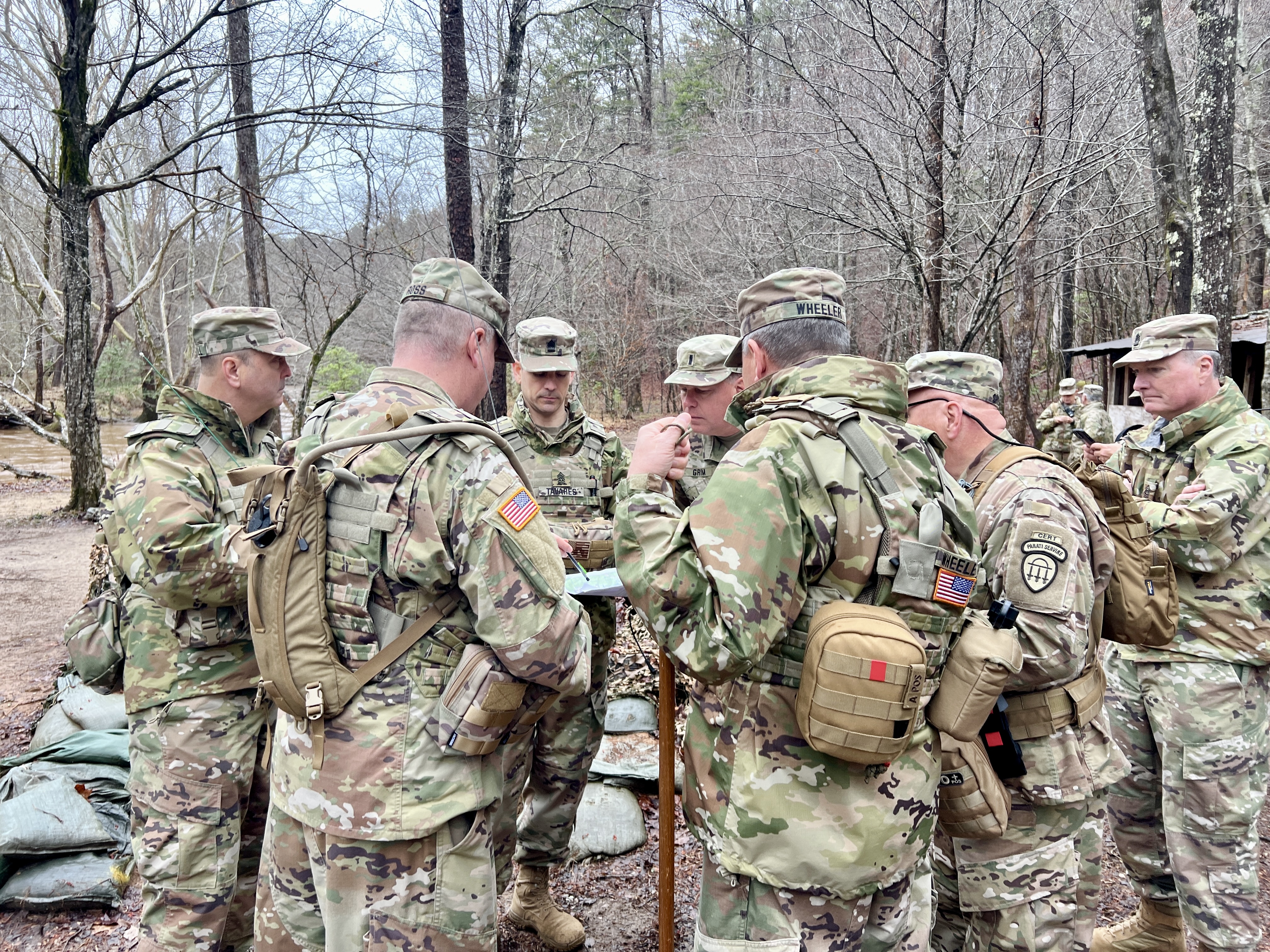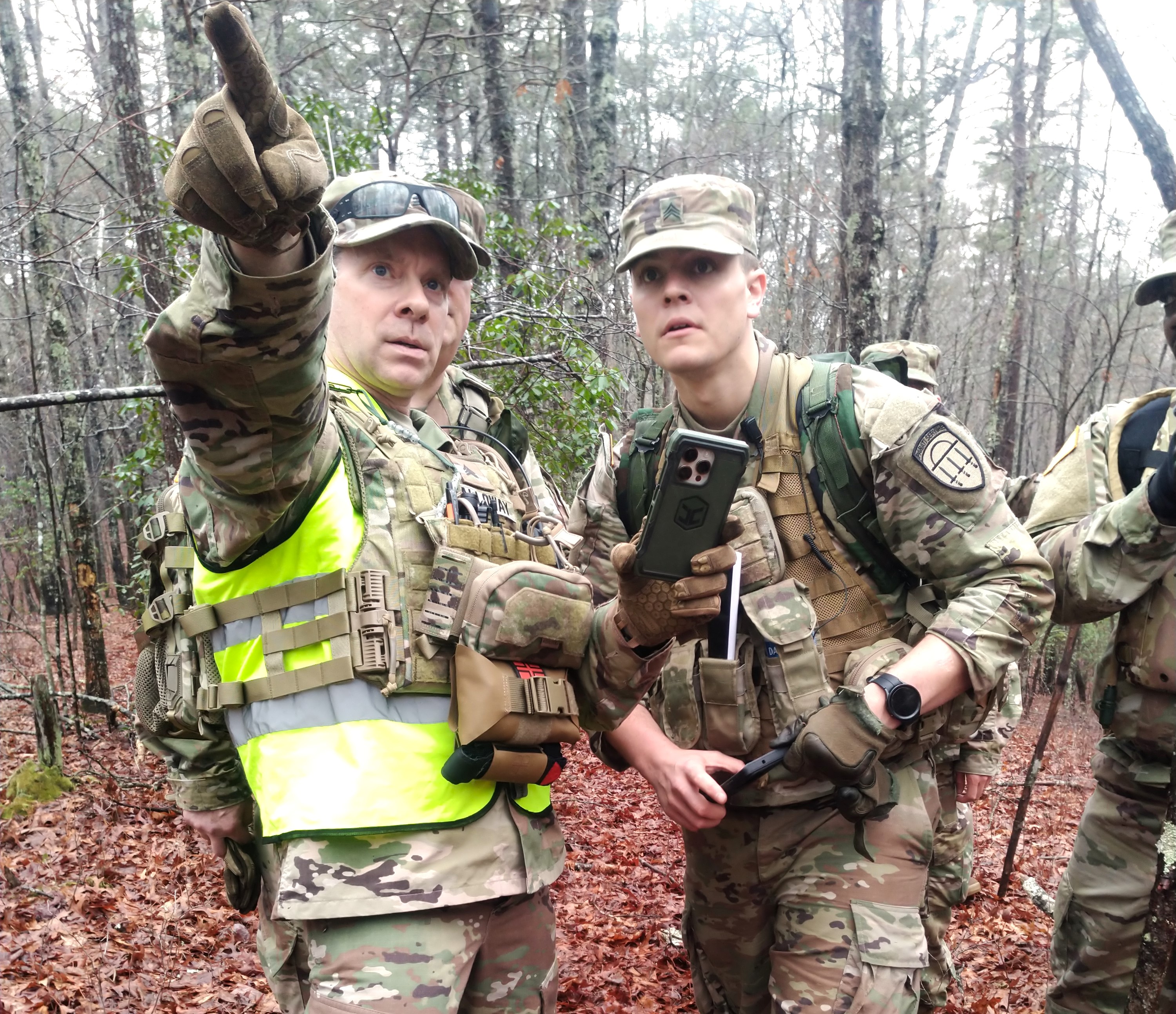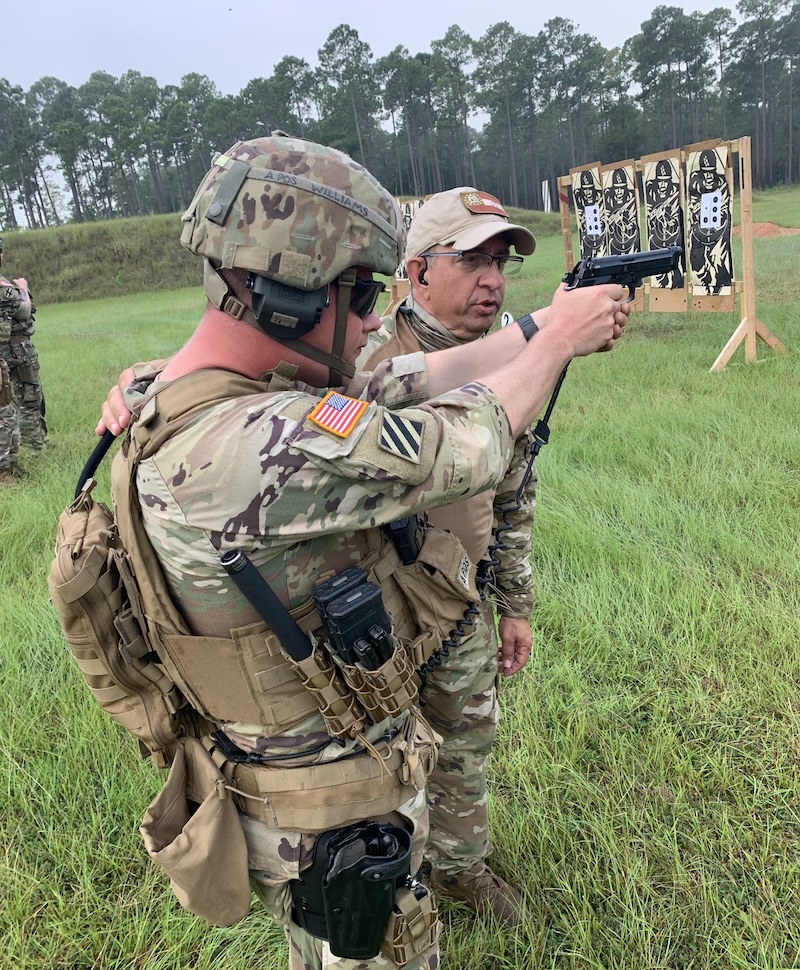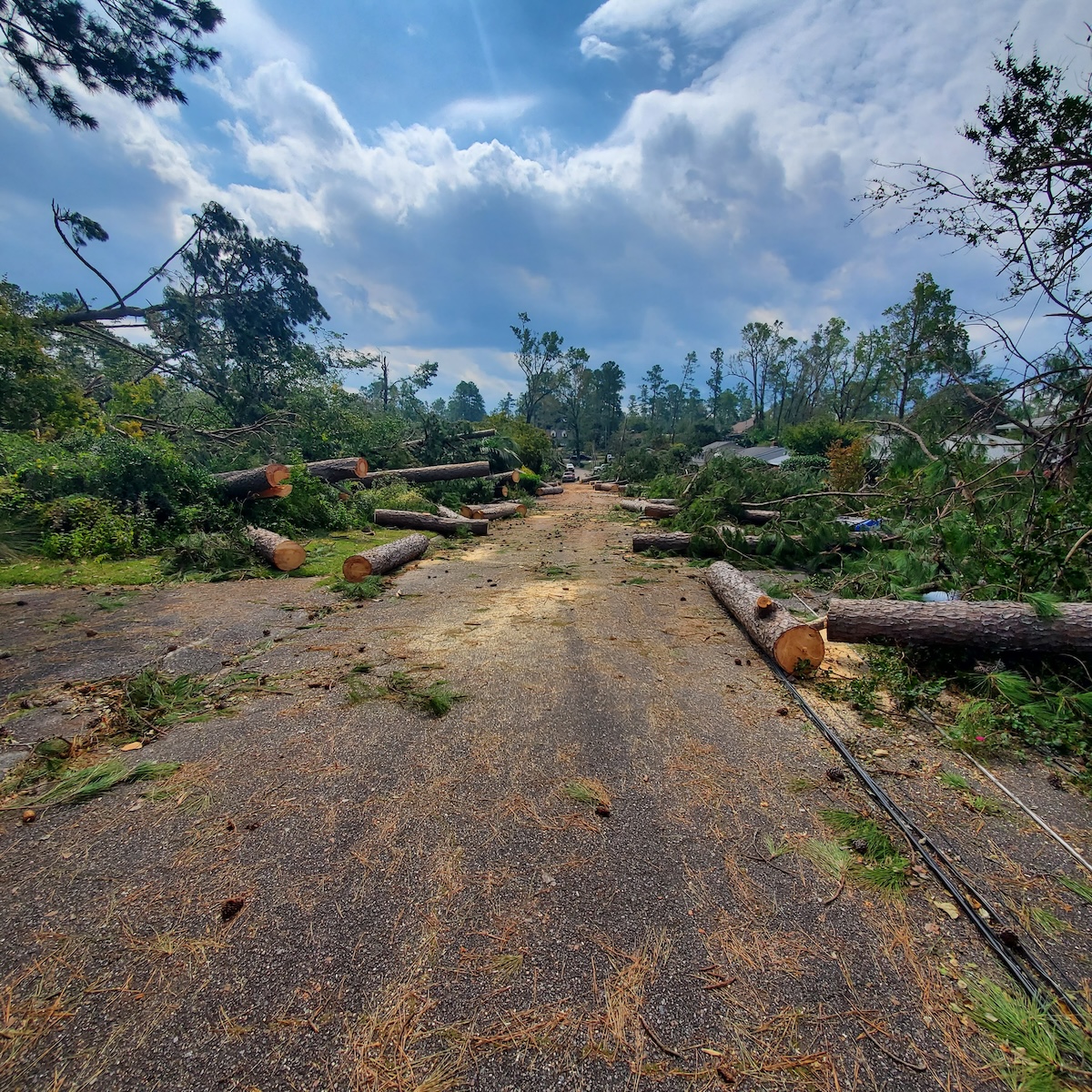1st Brigade Wilderness Search and Rescue Field Training Exercise
By Sgt. Lauren Boyle-Estheimer and Spc. George Yarnell, 1st Brigade, 4th Battalion

Georgia State Defense Force (GSDF) Soldiers from the 1st Brigade participated in a wilderness search and rescue (SAR) field training exercise (FTX) at Pine Valley Outdoor Recreation Facility in Dahlonega, Ga., March 9, 2024.
This FTX prepared Soldiers to respond to SAR emergency missions by training them at all levels of the operation, from individual skills to team dynamics and operational coordination. These trainings are crucial for ensuring the readiness and effectiveness of GSDF troops in real-world SAR emergencies.

Training for the Unpredictable: A Simulation of a SAR Operation
Soldiers from the 4th Battalion, 1st Brigade organized and led a practical field training exercise for the Soldiers of the 1st Brigade, focusing on SAR operations. The one-day exercise involved creating a mock scenario of missing persons to simulate a real-world situation. During the exercise, Soldiers from the 1st Brigade applied fundamental SAR techniques while working in teams to navigate through a wilderness environment in search of missing individuals. This hands-on training provided valuable experience and preparedness for Soldiers to respond effectively to real-life search and rescue missions.
The individual and collective Mission Essential Task List (METL) Soldiers used during the exercise included: search and rescue, land navigation, law enforcement assistance, and communications tasks.
Initiating The Exercise
On Wednesday, March 6, 1st Brigade Soldiers were issued a warning order (WARNORD) by 1st Brigade Headquarters to prepare for a Search and Rescue mission on March 9, in the vicinity of Dahlonega. This step enabled troops to prepare for mission deployment while unit leaders developed their plans to deploy to the mission. Upon arrival and briefing by the training group’s role players, the mission leadership issued an operations order (OPORD) to the assembled troops to establish and execute the plan for the SAR mission. The OPORD explains the “who, what, where, why, and how” of a mission in a standardized format.
Troop Movement to AO
On Saturday, March 9, 1st Brigade Soldiers reported to Pine Valley Outdoor Recreation Center in Dahlonega, the site of the SAR FTX. Soldiers from 4th Battalion, 1st Brigade served as the notional Local Emergency Management Agency (LEMA), requesting assistance from 1st Brigade Soldiers to conduct search operations for two missing persons last known to be in the Pine Valley Outdoor Recreation Center area for this mock exercise.
Conducting Search Operations
The search team was given the Last Known Point (LKP), where the persons were last known to be located based on physical evidence (personal effects, footprints, digital/cell phone traces). Troops were broken out into search teams and given a map of the area of operation (AO). Each search team was assigned an area on the map to search and clear.
The inclement weather added a layer of complexity to the exercise, emphasizing the unpredictable conditions often encountered in real-world scenarios. This also stressed to searchers that a SAR is an emergency. Cold temperatures, combined with wet clothing, heightened the risk of hypothermia to the lost persons in this mock scenario, as well as to the searchers themselves. As Soldiers navigated through the dense wilderness, the slick and muddy terrain presented a hazard, slowing their progress and requiring heightened attention to safety protocols.
During the exercise, search teams discovered several clues that they were able to positively identify as belonging to their missing persons. Finding and correctly interpreting these clues demonstrated the effectiveness of the Soldiers’ training in search and rescue techniques. Each clue assisted the search team in leading them directly to the position where the lost persons were eventually found.
Additionally, Soldiers practiced radio communication skills during the exercise that is crucial for effective coordination and information sharing between Soldiers in the field and the Tactical Operation Center (TOC). Clear and accurate radio transmissions are essential for conveying critical information, such as potential clues, team status, and location, which is vital for successful SAR missions in real-world scenarios. This exercise helped Soldiers hone their radio communication skills, ensuring they are well-prepared to effectively communicate during actual missions.
Conducting Rescue Operations
When searchers located the lost persons in this training exercise, teams first assessed the situation from a distance to ensure scene safety. Soldiers then contained the area for site security and provided first aid, as needed, to the patients. Conducting radio transmissions to the TOC allowed searchers to alert command personnel that they had successfully found the missing persons. It also provided the opportunity for searchers to request any necessary support or resources to complete the mission, such as special medical equipment for extraction or transportation assistance out of the AO. Overall, this structured approach ensured that the rescue operation was conducted efficiently and safely, with proper coordination between the field teams and command personnel.
The Soldiers deployed their unit Sked® stretcher and secured the patient requiring medical assistance for transport out of the AO. Rescue teams tirelessly negotiated their way through the wet and slippery terrain and delivered the patient to the TOC without incident.
Debriefing and Evaluation
Upon successfully finding both missing persons, all remaining field search teams were called back to the TOC for debrief. Soldiers conducted an after-action report (AAR) discussing what went well, what could be improved, and any lessons learned. This is an important step for refining procedures and improving performance after a training exercise.
The Importance of Training for Real-World Missions
Conducting field training exercises are essential for practicing and refining the response to SAR emergency missions at all levels of operation. By simulating realistic scenarios and providing hands-on training, Soldiers can develop and reinforce the skills necessary to effectively respond to SAR emergencies. This type of field training exercise is essential for maintaining readiness and ensuring that GSDF personnel are equipped with the skills and experience required to carry out their duties in challenging and high-stress situations.
For some Soldiers, this exercise reinforced their reasons for joining the GSDF. This was Pfc. Jennifer Goode’s first SAR FTX.
“I was excited about it because this is one of the areas that we focus on that is especially important to me. I think search and rescue is one of our more important missions.”
Goode joined the GSDF last year.
“I think that it’s critical for us to learn the skills we need to be able to go out and perform a mission like this,” she said, when asked how the training helped prepare 1st Brigade Soldiers for real-word scenario. “It’s very important for us to learn how to execute the plan effectively because we’re out there to save lives. This is excellent practice.”

A Mission Complement
When asked how the GSDF can complement LEMA during real-world SAR missions, Capt. William Crawford, the OIC of the exercise, stated, “I think we can be a force multiplier for them. I thought the teamwork was very good. Soldiers from different units worked well together, and the leadership group coordinated well together. I’m confident our search teams have the training and tools they need to be successful when deployed to the field.”
Leveraging Technology to Assist in SAR Operations
During the exercise, Soldiers also trained on utilizing the preferred SAR technology, SARTopo, in the field while communicating situational awareness with the TOC. SARTopo allows the TOC to create a search map of the area to be used to track the field personnel in real-time, easily mark items of interest, and coordinate the search effort using real-time wind and shading effects. Additionally, all field personnel have the same view of the search AO that the TOC is viewing allowing for command personnel to make more informed decisions during a search, as well as maintain troop accountability.
4th Battalion, 1st Brigade’s Commanding Officer, Capt. Ken Mayger, is a strong advocate for implementing SARTopo into real-world missions.
“The FTX was a great learning experience for the Brigade,” he said. “We used the training to introduce both the command level and the field level of troops to the SARTopo technology. The deployed teams have the same view of the search and can better coordinate with each other. The result is our teams will have complete confidence that an assigned search area has been cleared. More importantly, the TOC can clearly demonstrate the tasking with the authority in charge of the search.”
More on the 4th Battalion, 1st Brigade
The 4th Battalion, 1st Brigade’s primary training area of operation is the Pine Valley Outdoor Recreation Facility. The 4th Battalion, 1st Brigade, which specializes in wilderness SAR, maintains readiness to provide skilled assistance to local authorities in efforts to find lost persons, as well as to deploy in support of natural disaster relief operations in Georgia.
Acknowledgements
The 4th Battalion, 1st Brigade would like to thank the University of North Georgia for providing GSDF Soldiers with the facility to support the training operations and allowing the GSDF to train onsite for this mission-critical exercise.




